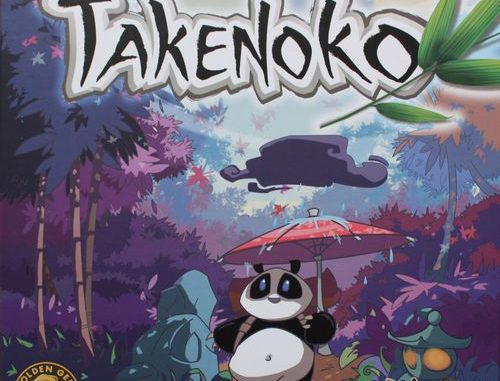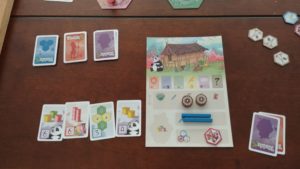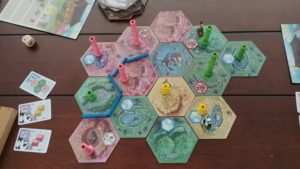
In honor of Gamer Nation Con V starting this week I’m going to take a look at a game I first discovered at the first GN Con; Takenoko. This is a game that’s easy to overlook because at first glance it has a fairly “cutesy” art style which suggests a very different type of game than it is. I assumed it was some kind of kid game. But my friend had heard it was good and plopped it onto the table. As it turned out, it was quite fun. It requires some strategy to play but nothing over the top. I’d put it on a comparable level to Ticket to Ride.

The gist of the game is you are playing members of the Japanese court in charge of caring for the Emperor’s bamboo forest that is home to a Panda, a gift from China. Your goal is, like many games, to acquire more points than the other players. You gain points by completing three different types of objectives: Panda, Plot, and Gardener. Panda objectives are accomplished by getting the Panda to eat bamboo of a particular color. Plot objectives require you to build out the garden to make a particular shape of color tiles. And the Gardener requires you to grow bamboo to a particular height in certain colors. Whenever you have a complete objective, on your turn, you can reveal that card and score it.
The basic game round is pretty straightforward. You roll the weather die to determine a special effect (we’ll cover those in a minute) then take two of the following actions:
- Pick up three plot tiles and place one.
- Move the Gardener in a straight line. If he lands on an irrigated plot, bamboo will grow on that plot and all adjacent irrigated plots of the same color.
- Move the Panda in a straight line. The Panda will eat one piece of the Bamboo on the plot he lands on.
- Pick up an irrigation token. Plots only grow if they are irrigated. All plots that are placed next to the starting tile are irrigated but after that, you need to run irrigation to them.
- Draw a new objective card. You can pick any of the three types but you have a limit of how many objectives you can have in your hand.

The weather die that you roll can dramatically affect which actions you decide to take each round, which can help with planning paralysis. Since you don’t know what the board state will be like after other players go, and you don’t know what effect you’ll roll, there’s little point in planning too much in advance. This helps keep the game moving and makes it easier for people who aren’t into much advance planning.
The special weather effects break the rules in a few ways:
- Sunny- You get a third action
- Rainy- Grow bamboo on any irrigated plot
- Windy- You can take the same action twice. This one is either amazing or useless. Sometimes you need to get the Gardener or Panda to a particular plot but since they can only go in a straight line, there’s no way to get them there with one movement.
- Storm- Move the Panda anywhere on the board and he eats the bamboo.
- Cloudy- Draw an Improvement tile. There are three types of improvements;
- Enclosure- the Panda cannot eat bamboo on this tile.
- Fertilizer- Bamboo grows two heights when it grows.
- Watershed- This tile is irrigated.
- The final die side allows you to choose any of the other effects.
The game proceeds until a player plays a certain number of objective cards (depending on the number of players). Then every other player has one more chance to take a turn. Whoever has the most points at the end is the winner.
The Gardener ones tend to be the most finicky objectives. They require bamboo to be grown to a certain height on a certain type of tile. For instance, two height three green stacks. Those are the worst. You’re trying to manage two different tiles to reach a particular height, all while other players might be eating them with the Panda or growing them out of sync with their Gardeners.
Likewise, the Plot objectives really come down to the luck of which tiles you draw. If you need three pink plots in a triangle shape, if someone places another color in the wrong spot, you might have to start over trying to get three pinks. And you might never draw any. Plus you need to irrigate the tiles before you get your points.
Panda objectives are by far the easiest to accomplish. Move the Panda and have him eat between two and four pieces of bamboo. The only hindrance is the straight line requirement or an Enclosure keeping you from eating the color you need. But the main downside to Panda cards is they are worth fewer points and you can only move the Panda once per turn (depending on weather). If you focus just on Panda objectives you probably won’t win.
It is not a very quick game but it won’t drag on for hours either. It’s a great game for families or a game night. Younger kids won’t really get the strategy but will enjoy the colors and moving the Panda around to eat things. It doesn’t require any reading so even younger kids can understand the objectives from the picture. Definitely, a recommended game to play.
Wayne Basta
Latest posts by Wayne Basta (see all)
- X-Wing Tier List – Rebels - May 10, 2023
